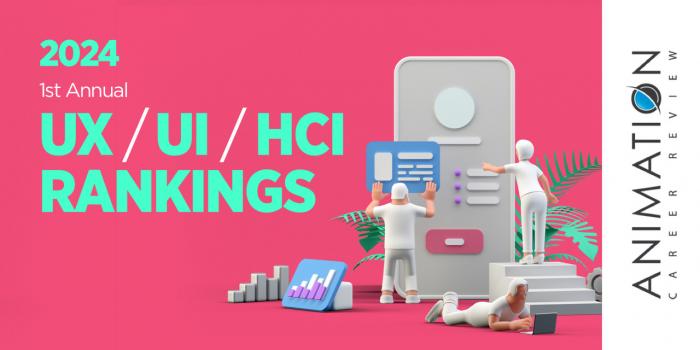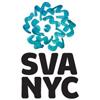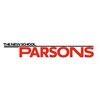
Did you know? Savannah College of Art and Design user experience (UX) design students solve real-world problems for major companies such as 3M, Instagram, Capital One, Hewlett-Packard, The Home Depot, and Microsoft. Learn more.

| Ranking | School | State |
|---|---|---|
| 1 | Carnegie Mellon University | Pennsylvania |
| 2 | University of Maryland | Maryland |
| 3 | School of Visual Arts | New York |
| 4 | The New School – Parsons School of Design | New York |
| 5 | George Mason University | Virginia |
Our 2024 rankings of the Top 5 graduate UX/UI/HCI school programs on the East Coast. For an explanation of ranking criteria, click here.

Carnegie Mellon University (CMU) has two graduate programs for students seeking leadership roles in UX/UI/HCI. Options include the Master of Human-Computer Interaction (MHCI) and the Master of Design (MDes) in Design for Interactions.
The MHCI at CMU is the first program in the world dedicated to preparing professionals for careers related to HCI, user-centered research, and User-centered Design (UCD). Launched in 2020, Human-Computer Interaction at CMU is part of the School of Computer Sciences’ (SCS) Human–Computer Interaction Institute (HCII).
The MHCI at Carnegie Mellon University is a three-semester, interdisciplinary program that requires seven core HCI courses. This includes HCI Pro-Seminar: Communications in HCI; User-Centered Research and Evaluation (UCRE); Interaction Design Studio 1 and 2; Programming Usable Interfaces (PUI) or Software Structures for User Interfaces (SSUI); and HCI Project I and II.
Electives for this STEM-designated program allow students to take courses within the Robotics Institute; Dietrich College of Humanities; the School of Design; Tepper School of Business; the College of Fine Arts; and the School of Computer Science. Some popular elective courses include UI in Developing Worlds; Cognitive Modeling for HCI; Tangible Interaction Design Studio; Gadgets, Sensors & Activity Recognition in HCI; Dramatic Structures of Interactive Games; Applied Machine Learning; and Robotics.
The MHCI program at Carnegie Mellon University culminates with the MHCI Capstone. This seven-month experience consists of a research and design team project with an external industry client. Past clients have included NASA, Meta, Cisco, PNC Bank, Amazon Music, Zazzle, CarMax, Discover, American Eagle Outfitters, Mastercard, the Pittsburgh Foundation, Pacific Northwest National Laboratory (PNNL), and Clemente Museum.
The MDes in Design for Interactions at Carnegie Mellon University is housed in the School of Design (SoD). One of the oldest design programs in the nation, the CMU SoD serves approximately 250 students enrolled in undergraduate, graduate, and doctoral degree programs. CMU is one of the few universities in the U.S. to provide design degrees at all levels.
Designed for students with a degree in a design-related field and at least one year of professional experience, the MDes attracts students from the user experience design, communication design, service design, product design, and architecture fields. The program is interdisciplinary, which allows students to pursue courses and opportunities across departments. Course examples for the program include Designing for Interactions; Design Lab; Research Based Design for Interactions; Design Seminar; Advanced Interaction & Service Design Concepts; and Communication Design Theory & Practice.
The MDes program also provides the opportunity to work on individual and team-based projects while exploring design principles, theories, and tools for designing interactions. Seminars, studios, and labs are part of the program as well as a thesis and final project (individual). The thesis consists of the following six courses: Thesis Prep I-IV and MDes Project I-II.
The MDes in Design for Interactions at CMU is a terminal degree in design. This means, graduates are prepared to pursue leadership roles across industries; seek entry-level teaching and research positions at universities; or enroll in a design-focused PhD program.
CMU School of Design graduates are employed at top design firms, global companies, nonprofits, and more. Examples include Apple, Google, Microsoft, IDEO, Facebook, Skype, Pinterest, R/GA, Mayo Clinic, Volkswagen/Audi, Whirlpool, Motorola, the Carnegie Museums of Pittsburgh, and global creative agency Isobar.
Founded on November 15, 1900 by industrialist and philanthropist Andrew Carnegie, Carnegie Mellon University opened its doors as Carnegie Technical Schools. Today, this private global research university provides more than 200 programs to approximately 16,780 students representing 126 countries. In addition to the main campus in Pennsylvania, CMU has campuses in California's Silicon Valley and Doha, Qatar.
Housed across seven colleges and schools, Carnegie’s academic programs are also provided in Africa, Asia, Australia, Europe, Mexico, and Portugal. Carnegie Mellon University is accredited by the Middle States Commission on Higher Education (MSCHE).

The College of Information Studies (INFO College or iSchool) at University of Maryland (UMD) is home to the graduate Human-Computer Interaction (HCIM) program. Leading to an MS, the HCIM program provides opportunities to connect with one of more than 400 top government and industry partners through the INFO Corporate Partnership Program. Employers, corporations, and organizations engage with students through hands-on capstone projects, internships, and campus events.
Examples of industry and government partners include the U.S. Department of Defense, Smithsonian, National Archives, Department of the Interior, Microsoft, the National Institutes of Health (NIH), Google, IBM, World Bank, CISCO, the Internal Revenue Service (IRS), Adobe, PayPal, Capital One, Fidelity, Verizon Wireless, Bloomberg, PBS, Nickelodeon, the Washington Post, American Airlines, Honda, BlueCross BlueShield, and Blackboard.
The College of Information Studies at University of Maryland UMD also provides hands-on learning opportunities at the school’s research centers and labs. Examples include the Human-Computer Interaction Lab (HCIL); the Center for Archival Futures (CAFe); the Values-Centered Artificial Intelligence (VCAI) Initiative; and the Computational Linguistics and Information Processing (CLIP) Lab.
The interdisciplinary HCIM MS program at University of Maryland requires 30 credit hours. This includes 12 credits of core courses, 12 credits of electives, and six credits including two Capstone or Thesis courses. Core courses explore Human-Computer Interaction, User Experience, User Interfaces, Design, Research Methods, Data Analysis, and Programming. Electives allow students to focus in an area such as Data Visualization, Usability, or Privacy.
For the two-semester Capstone, students work in groups to conduct user research and prototype designs for real clients. This option allows students to gain valuable experience in project management, UX design, user research, and front-end development. The two-semester Thesis option is a self-directed research-focused experience that results in a 70- to 100-page thesis. This option is ideal for students who wish to pursue a research-intensive career or pursue a PhD.
The iSchool at University of Maryland has a 96.5% placement rate (employment or continued education). Graduates are prepared to pursue a variety of roles such as User Experience Designer, User Interface Designer, User Experience Researcher, Interaction Designer, Visual Designer, Product Designer, Information Architect, and Usability Analyst.
UMD iSchool alumni have gone on to reconstruct the New York Times UX; address Chicago’s information infrastructure; govern the American Library Association (ALA); and oversee social media for the United Nations. Alumni have also worked with (or currently work for) companies and organizations such as Google, Deloitte, Aspera (IBM), Capital One, PBS, American Airlines, the New York Times, Cisco, Johns Hopkins University, the NIH, Ericsson, PayPal, VistaPrint, and Blackboard.
Founded in 1856, University of Maryland is the flagship institution of the State of Maryland. The school employs more than 14,000 faculty and staff members that serve approximately 40,710 students. UMD provides more than 300 academic programs across 12 colleges. University of Maryland is accredited by the Middle States Commission on Higher Education (MSCHE).

The School of Visual Arts (SVA) has an Interaction Design MFA that consists of 60 credit hours. Learning for this collaborative program takes place in a studio environment where students work in transdisciplinary teams to solve real-world problems. Projects and activities take place in the studio and on-site at New York organizations. Students will have opportunities to gain additional experience through participation in the Summer internship program. Internships take place between the first and second years of the MFA program.
Students can expect to take courses such as Fundamentals of Physical Computing; The Advanced Fundamentals of UX; Framing User Experiences; Narrative and Interactivity; Conversation Design; Service Design and Transformation; Hello World: The Logic of Interaction; Strategic Innovation in Product/Service Design; Design Management; Augment Ideas into Reality; Foundations for Responsible Design; Future (Im)perfect: Exploring the Hidden Ethics of Emerging Technologies; Leadership, Ethics and Professional Practices; Smart Objects; and Entrepreneurial Design.
In the final year of the Interaction Design MFA program at the School of Visual Arts, students will complete the Thesis requirement across two courses—Thesis I: Development and Thesis II: Presentation. While most courses are worth 1-3 credits, Thesis courses are worth six credits each.
Graduates are prepared for careers in UI/UX Design, Interaction Design, and many others across industries. Some Interaction Design MFA graduates have gone on to launch their own start-ups, while others have been hired at companies and organizations such as Apple, Reuters, Facebook, Johnson & Johnson, R/GA, IDEO, X (formerly Twitter), frog design, and Yelp.
The School of Visual Arts was founded in 1947 as the Cartoonists and Illustrators School by artists Silas H. Rhodes and Burne Hogarth (Tarzan). With over 1,100 New York City-based professionals working in the arts as faculty, SVA serves more than 7,000 students enrolled in 31 programs. To date, the School of Visual Arts has graduated more than 40,000 artists, designers, writers, filmmakers, photographers and other creative professionals. SVA is accredited by the Middle States Commission on Higher Education (MSCHE).

Parsons School of Design is part of The New School. Within Parsons are two graduate paths to study UX/UI including the Design and Technology MFA and the Master of Professional Studies (MPS) in Communication Design. Across options, students have access to The New School XReality Center—home to the XR Reality Lab and XR-related events. The Lab emphasizes immersive learning; supports research and student projects; and hosts a variety of workshops and meetups.
The Design and Technology MFA is a 60 credit hour program that explores the interactive, visual, and narrative aspects of design technology. This highly collaborative program focuses on software programming and computation. Course examples include xFab Lecture and Lab; Cloud Salon; Creative Practice Seminar; Major Studio; and Critical Computation Lecture and Lab.
Students in this STEM-designated program will also complete a number of projects. Typical MFA projects involve interaction design, game design, new media art, digital fabrication, web and mobile apps, wearable technology, critical design, and data visualization. MFA students have had the opportunity to collaborate on projects with external partners such as Ralph Lauren, The Metropolitan Museum of Art (The Met), United States Holocaust Memorial Museum, Human Rights Watch, and One Plus.
The Design and Technology MFA at Parsons School of Design culminates the Thesis, which students will complete across two courses. Final projects are presented at the Design + Technology BFA/MFA Thesis Show. In 2023, the event was titled Entropy.
Graduates are prepared to pursue positions in areas such as UX/UI Design, Interaction Design, Game Design, Computer Software and Hardware Design, AR/VR, Motion Graphics, Virtual Reality and Immersion Experience Design, Mobile and Application Design, and Web Design.
The Communication Design MPS is a one-year, full-time program that allows students to supplement required coursework with two electives from other departments. Courses may explore aeras such as data visualization, marketing, and psychology.
During the first semester of the program, students will take the following required courses: Typography and Interaction; Major Studio 1; and Visual Culture Seminar. In the second and final semester, students will complete Typography and Interaction 2; Major Studio 2; and Methods and Practices. The program culminates with a final portfolio of the students best work.
Graduates of the Communication Design MPS program at The New School – Parsons School of Design are prepared for UX/UI careers in across industries. Examples include technology, education, health care, government, e-commerce, gaming, retail, banking, insurance, and travel.
The New School was founded in 1919. Serving approximately 10,815 students, the school provides more than 120 degree and diploma programs across six colleges and schools, including Parsons Paris. The New School is accredited by the Middle States Commission on Higher Education (MSCHE).

The College of Engineering and Computing at George Mason University (GMU) is home to the School of Computing, which houses the Department of Computer Science (CS). Serving approximately 3,765 student, GMU CS provides BS, MS, and PhD programs with a number of concentration and interdisciplinary options. At the graduate level, the school’s Information Systems (INFS) MS has a Human-Centered Computing concentration that requires a minimum of four additional courses (12 credit hours) outside general program requirements.
Students in this concentration will take two courses from the following: Advanced Human Computer Interaction; Interaction Design and Accessibility (AIT 642) or Interaction Design and Accessibility (COMP 642); and Interactive Visualization and Data Analytics. The remaining courses will come from electives. Options include User Interface Design and Development; Human-Computer Intelligent Interaction; Data Analytics in Social Media; Ethical and Legal Challenges in Computing; and Accessibility and Assistive Technologies.
Students will take 15 credit hours of courses such as Database Systems and Rapid Information Systems Prototyping, as well as electives from multiple areas. These include Information Systems, Applied Information Technology, Information Security and Assurance, Software Engineering, Computer Science, Operations Research, Electrical and Computer Engineering, Systems Engineering, Psychology, and Statistics.
Just a few elective examples include User Interface Design and Development; Modeling, Simulation, and Gaming; Statistical Graphics and Data Visualization; Global Optimization and Computational Intelligence; Real-Time Embedded Systems; Interactive Graphics Software; Machine Learning; and Enterprise Architecture. With consent of a faculty advisor, students may complete a six-credit MS Thesis as part of the electives.
Graduates of the INFS MS program at George Mason University are prepared for leadership roles across industries. Alumni have been hired at companies such as Microsoft, Amazon, Google, HP, Boeing, the Federal Government, Intel, Capital One, KPMG, Goldman Sachs. Barnes & Noble, Deloitte, Raytheon, IBM, Ernst & Young, Intel, PwC, Accenture, FEMA, AOL, Booz Allen Hamilton, ESPN, United Airlines, REI Systems, the Environmental Protection Agency (EPA), Grainger, and the Brazilian Air Force.
Founded in 1949 as a branch of the University of Virginia, George Mason University serves approximately 39,050 students from all 50 states and 130 countries, making it the largest public university in the Commonwealth of Virginia. GMU offers more than 200 degree programs across 10 colleges and schools. George Mason University is accredited by the Southern Association of Colleges and Schools Commission on Colleges (SACSCOC).